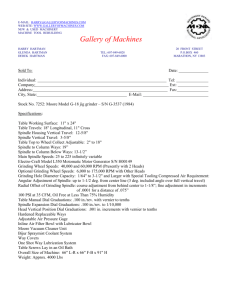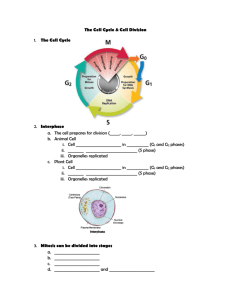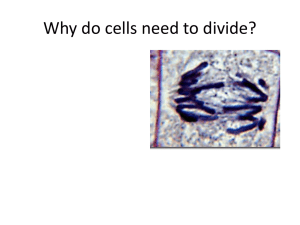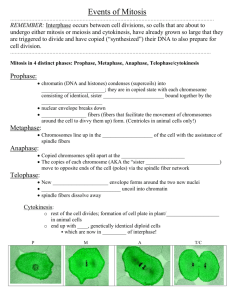Electric 30,000 RPM Shave Spindle for C Frame Riveter and High
advertisement
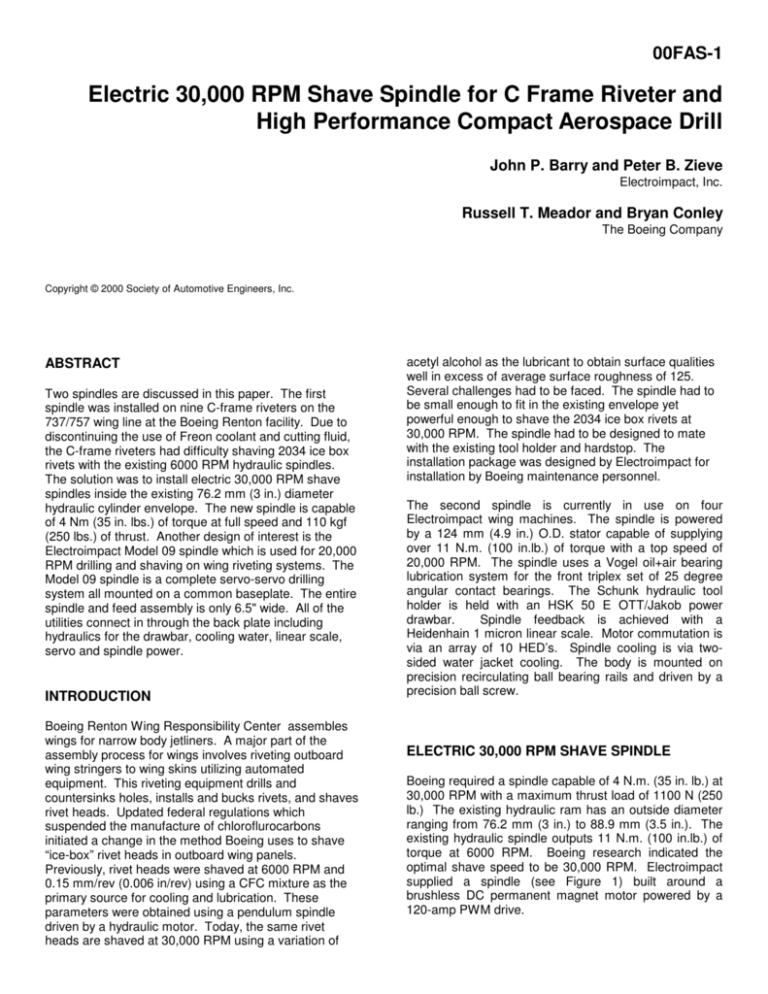
00FAS-1 Electric 30,000 RPM Shave Spindle for C Frame Riveter and High Performance Compact Aerospace Drill John P. Barry and Peter B. Zieve Electroimpact, Inc. Russell T. Meador and Bryan Conley The Boeing Company Copyright © 2000 Society of Automotive Engineers, Inc. ABSTRACT Two spindles are discussed in this paper. The first spindle was installed on nine C-frame riveters on the 737/757 wing line at the Boeing Renton facility. Due to discontinuing the use of Freon coolant and cutting fluid, the C-frame riveters had difficulty shaving 2034 ice box rivets with the existing 6000 RPM hydraulic spindles. The solution was to install electric 30,000 RPM shave spindles inside the existing 76.2 mm (3 in.) diameter hydraulic cylinder envelope. The new spindle is capable of 4 Nm (35 in. lbs.) of torque at full speed and 110 kgf (250 lbs.) of thrust. Another design of interest is the Electroimpact Model 09 spindle which is used for 20,000 RPM drilling and shaving on wing riveting systems. The Model 09 spindle is a complete servo-servo drilling system all mounted on a common baseplate. The entire spindle and feed assembly is only 6.5" wide. All of the utilities connect in through the back plate including hydraulics for the drawbar, cooling water, linear scale, servo and spindle power. INTRODUCTION Boeing Renton Wing Responsibility Center assembles wings for narrow body jetliners. A major part of the assembly process for wings involves riveting outboard wing stringers to wing skins utilizing automated equipment. This riveting equipment drills and countersinks holes, installs and bucks rivets, and shaves rivet heads. Updated federal regulations which suspended the manufacture of chloroflurocarbons initiated a change in the method Boeing uses to shave “ice-box” rivet heads in outboard wing panels. Previously, rivet heads were shaved at 6000 RPM and 0.15 mm/rev (0.006 in/rev) using a CFC mixture as the primary source for cooling and lubrication. These parameters were obtained using a pendulum spindle driven by a hydraulic motor. Today, the same rivet heads are shaved at 30,000 RPM using a variation of acetyl alcohol as the lubricant to obtain surface qualities well in excess of average surface roughness of 125. Several challenges had to be faced. The spindle had to be small enough to fit in the existing envelope yet powerful enough to shave the 2034 ice box rivets at 30,000 RPM. The spindle had to be designed to mate with the existing tool holder and hardstop. The installation package was designed by Electroimpact for installation by Boeing maintenance personnel. The second spindle is currently in use on four Electroimpact wing machines. The spindle is powered by a 124 mm (4.9 in.) O.D. stator capable of supplying over 11 N.m. (100 in.lb.) of torque with a top speed of 20,000 RPM. The spindle uses a Vogel oil+air bearing lubrication system for the front triplex set of 25 degree angular contact bearings. The Schunk hydraulic tool holder is held with an HSK 50 E OTT/Jakob power drawbar. Spindle feedback is achieved with a Heidenhain 1 micron linear scale. Motor commutation is via an array of 10 HED’s. Spindle cooling is via twosided water jacket cooling. The body is mounted on precision recirculating ball bearing rails and driven by a precision ball screw. ELECTRIC 30,000 RPM SHAVE SPINDLE Boeing required a spindle capable of 4 N.m. (35 in. lb.) at 30,000 RPM with a maximum thrust load of 1100 N (250 lb.) The existing hydraulic ram has an outside diameter ranging from 76.2 mm (3 in.) to 88.9 mm (3.5 in.). The existing hydraulic spindle outputs 11 N.m. (100 in.lb.) of torque at 6000 RPM. Boeing research indicated the optimal shave speed to be 30,000 RPM. Electroimpact supplied a spindle (see Figure 1) built around a brushless DC permanent magnet motor powered by a 120-amp PWM drive. MECHANICAL DESIGN OF SPINDLE – The spindle is powered by a brushless DC motor. The stator outside diameter is 63.5 mm (2.5 in.), stack length is 102 mm (4 in.) The outside diameter of the magnet section of the rotor is 32 mm (1.2 in.). In order to make the shaft as stiff as possible, the magnets were embedded directly in slots in the outside diameter of the shaft. The shaft material had to be chosen to provide adequate magnetic properties. High carbon steels could not be used because high carbon content deflects the magnetic flux lines and decreases the amount of magnetic energy available for torque. The material selected was 17-4 PH stainless steel. The 17-4 provided the magnetic properties required and the ability to harden to 45 Rc. The Boeing standard shave cutter is screwed into an adapter. The adapter is held in the shaft with a TG-50 collet and nut. The shave cutter may be changed at the adapter without disturbing the TG-50 collet. If the adapter is damaged or a shave cutter becomes seized into the adapter, the adapter can be swapped at the TG50 interface. Spindle bearings - The back bearings are housed in the hydraulic ram with the stator. The back bearings are arranged in a back to back duplex set. The outer races of the back bearings are located in a precision ground bore and are allowed to float axially relative to the ram. This prevents the generation of thermal stress in the shaft being generated by thermal growth. The front bearing housing bolts to the lower end of the ram. The front bearings consist of a triplex set of hybrid ceramic ball bearings with 25 degree angular contact. The contact angle was chosen to allow for maximum thrust capability of the spindle. Many spindles are supplied with 15 degree angular contact bearings; however, the lower contact angle reduces the thrust rating by as much at 35% and decreases the axial stiffness by half while only increasing rated speed by 6%. The axial stiffness of the bearing set is 88 N/micron ( 500,000 lb./in.). The rated thrust load of 1100 N (250 lb.) would result in a bearing deflection of 13 microns (0.0005 in.). The speed of the bearings is 1.0 million nDm allowing for grease lubrication. This speed is at the upper range of allowable speeds for grease. Bearing life is optimized by allowing the spindle to coast between shave operations. Spindle Balance Assembly – The balance assembly consists of all the rotating parts of the spindle and the front bearing housing and seals (see Figure 2). The use of a triplex set of bearings housed in the front bearing housing and rear bearings arranged in a back to back duplex set allow for a modular unit. The balance assembly is balanced to ISO G0.4 at 30,000 RPM. If a machine crash happens, the balance assembly may be removed directly from the bottom of the ram and a new balance assembly can be installed. Because feedback is via the HED’s embedded in the stator, adjustment of commutation is not required. Within 30 minutes, the balance assembly can be replaced and the machine can be up and running. Spindle Cooling - The shave spindles were designed for the optimal duty cycle of the C-frame riveters of 10 sec./rivet. The heat generated by the spindle ranges from 350 W during shaving to 0 W during coast. The time weighted average heat dissipation is 50 W. Cooling was achieved through two routes. The first route was heat conducted through the ram, into the hydraulic fluid, to the cylinder housing. The heat could not be conducted out through the hydraulic oil because the oil exiting the piston is not vented directly to the tank. The second route is compressed air plumbed in the top end of the spindle. The air travels around the rear bearing housing, between the rotor and stator and out through vent holes in the front bearing housing. The aim of forced air cooling is to prevent the heat from the motor windings from migrating into the bearings. Due to the high thrust load expected for the spindle, a large preload in the front bearings was required. The high preload can result in significant heating of the bearings. Bearing preload is highly dependent on several variables that are difficult to control. A 2.5 micron (0.0001”) change in shaft diameter can change the amount of thrust required to overcome preload by 200 N (50 lbs.). Bearing cooling was achieved through natural convection. Spindle Motor Design The brushless DC servomotors were chosen for their high power density and ability to be run at very high speeds. The solution was to install a small motor, due to size constraints, and power it with a very large drive. The stator has a torque constant of 0.03 N-m./Amp (0.2 in.lb./Amp), see Figure 3(a). The MCS drive is designed to maintain maximum torque and minimum heat generation by keeping a 90 degree torque angle between the stator field and the rotor field. An induction motor requires slip to produce torque and often generates high temperatures in the rotor from the induced current. The synchronous motor used here exhibits no slip between the rotor and stator fields. The use of permanent magnets on the rotor results in very little heat generated in the shaft. Heat is undesirable in the shaft due to the effect of thermal growth. Thermal growth can increase running torque in the bearings and lead to thermal stresses in the shaft if the bearings are improperly constrained. Cable Routing Issues – One drawback of the use of the large motor drive is that very large, 13.3 mm^2 (6 AWG), power cables must be used for spindle power. The power cables required a minimum bend radius of 100 mm (4 in.) The previous hydraulic supply and return lines had been run to a manifold on the shuttle box. Fortunately, there was sufficient room inside the head of the riveter to run an IGUS energy tube from the shuttle box to the A-axis rotating head. By running the cable track parallel to the shuttle axis, it was possible for the single axis of the energy tube to accommodate both shuttle and shaver feed motions. Spindle Control – The large available torque and the small inertia of the rotor makes it necessary to prescribe a controlled ramp rate for the spindle. This was achieved with a GE/Fanuc 9030 PLC. The use of the PLC allowed for precise speed control of the spindle throughout the rivet cycle. The PLC also managed error handling and communication with the Allen Bradley controller on the overall machine. The PLC monitored spindle RPM as the shaft decelerated after each shave operation. When the drive was enabled for the next fastener, the PLC smoothly accelerated the spindle back up to full speed. The spindle also incorporates thermocouples which are in contact with the front and rear bearings. The thermocouples are fed to linearizing modules, the output from which are fed to analog inputs on the PLC. Therefore the PLC is monitoring the bearing temperatures and will flag an error if required. MCS provided the stators with a thermocouple which fed down the motor slot. This alleviated the requirement to cut a slot in the ram to lead the front thermocouple to the back of the ram. Rotor Magnetic Design The motor is designated the B06-102 by MCS. The traction area of the motor is 102 mm long (4" long). The rotor is manufactured with eight axial slots with flat bottoms machined in. The slots are over 4.5" long and over 1/4" wide. High energy density magnets (NeFeB) are bonded into the slots. A row of magnets is bonded into each slot. The resultant row of magnets is 4.5" long by 0.25" wide. The magnet line is 1/2" longer than the stator. The 1/2" that sticks out on the back end activates the HEDs that are used for commutation. The NeFeB magnets are magnetized across the thin dimension, which is 0.156". They are bonded into the slots, machined and overwrapped with fiberglass. The individual magnets are 0.5"x0.25"x.156". The magnetic pattern is shown in Section A-A. Stator Design The stator is an eight pole motor. Three HEDs are built into the stator spaced at 120 degrees. The output transistor in each HED switches on when the outward south pole face passes the HED. Therefore each HED switches on four times for each mechanical rotation of the shaft. The four HED switches turn on 120 degrees out of phase. The HEDs have a 500 Gauss hysteresis band. The stator is bonded into the hydraulic ram. The stator incorporates a thermistor which provides temperature feedback to the MCS drive. Drive Design The MCS motor design develops a surprising amount of torque in a small package. (see the torque-speed curve in Figure 3A) This is for a rotor of 1" diameter through the stator and a stator of 2.5" diameter. The stator fits into a 3" ram, which is the existing hydraulic ram diameter. In the Boeing Renton shaver application we are using the SA-5000 from MCS. The SA-5000 drive outputs 120 amp continuous and 150 amp peak. The drive uses a three phase bridge of IGBTs in the output. The drive is fixed frequency using pulse width modulation. Each of the three motor power wires is always connected either to the positive bus terminal or the negative bus terminal. The DC bus in the drive is 340 VDC. The drive is powered off of a 240 VAC 3 phase line which can pull as much as 150A(rms). Since the riveting machine did not have adequate 240VAC to supply such a large electrical load Electroimpact supplied 30KVA 3 phase transformers on each machine. These transformers step-down the 480VAC which is taken off the riveter power rail to 240VAC. The spindle position feedback of the HEDs is fed back to the MCS drive. The positive transitions of the HEDs add to the current command and the negative transitions subtract. The resulting sine wave-like signal is shown in Figure 7. Note that there are six transitions per cycle. Since four outward facing magnets pass by three HEDs per mechanical rotation of the shaft, this results in four command cycles per rotation which is correct for an eight pole motor. ELECTRIC 20,000 RPM DRILL SPINDLE The Model 09 spindle is currently in use on one spar machine and three wing machines. The spindle (see Figure 4) has been designed to drill fastener holes in titanium, composite, and aluminum alloys. MECHANICAL DESIGN OF SPINDLE – The spindle consists of a hardened steel shaft located with hybrid ceramic bearings. The spindle body is housed in a 7000 series aluminum body and is cooled with symmetric twosided water jacket cooling. The spindle body bolts directly to eight preloaded precision recirculating ball bearing cars on two parallel rails. The feed axis is driven with a GE/FANUC Alpha 3 Feed motor and a Star Linear 20 mm lead precision ballscrew. Spindle Shaft Design – The spindle shaft was designed around the HSK 50 E power drawbar (see Figure 5) purchased from OTT/Jakob GMBH. The HSK tooling was preferred over the more standard ISO taper technology to increase the capabilities of the spindle. The HSK 50 E tool holder requires a 50 mm (1.97”) minimum diameter at the face of the spindle and delivers a minimum rated torque of 26 N.m. (234 in.lb.). This torque is accomplished without the aid of drive keys which is an indication of the increase in dynamic stiffness. The HSK taper provides nearly twice the static stiffness compared to the equivalent ISO steep taper. The pull-in force of the HSK clamping system increases with increasing spindle RPM. The HSK taper differs from the ISO steep taper in the angle of taper (ISO is 12:3.5, HSK is 10:1 on diameter) and the HSK tool holder mates on the face as well as the taper of the spindle. Because the tool holder contacts the face of the spindle, presetting off-line becomes easier to accomplish. The HSK clamping fingers result in high bearing stresses in the spindle shaft. The shaft is made of 8620 carburized and hardened to 700+100 HV (62 Rc) to a 1 mm (0.04 in.) depth. The shaft is selectively hardened to allow for balancing. Spindle Bearings – As with the 30,000 RPM spindle, 25 degree angular hybrid ceramic bearings are used in a triplex set. In order to achieve 20,000 RPM with the 55 mm bore bearings (1.3million nDm), oil+air bearing lubrication was selected over grease. The Vogel oil+air lubrication system provides a steady flow of air with entrained oil flow directed at the bearings through a nozzle (see Figure 6). Each bearing has one nozzle and one drain hole. One drop of oil is injected into the air line every 10 minutes. The oil is carried along the inside diameter of a 4 mm tube, entrained in the 0.5 micron filtered and dry air. The 10 meter length of air line between the oil injection point and the nozzle allows for even oil distribution at the nozzle. This method of lubrication is often referred to as starvation lubrication. The amount of oil must be maintained at a precise level whereby any less lubrication results in rapid bearing heating due to metal to metal contact and any more oil results in excessive heating caused by shearing of the extra oil. The viscosity of oil had to be carefully chosen to ensure a minimum of 15 centistokes of viscosity at the spindle running temperature. SPINDLE MOTOR DESIGN - The motor is a brushless DC motor powered with a 90-amp PWM drive. Commutation is achieved with 10 HED sensors potted in the end turns of the stator. The Model 09 has a 4.9” diameter stator which allows for a larger torque constant (0.9 in.lbf./Amp) than the stator used on the 30,000 RPM shaver (see Figure 3(b)). The 10 HED commutation allows for smooth cutting torque down to 300 RPM. The spindle has been used to machine titanium, composite, stainless steel and aluminum, as well as combination stacks of the above materials. Motor Magnetic Design The motor is a B12-127 from MCS. The motor is an eight pole design similar to the Renton shaver. The stator slots are 5" long with the magnet line on the rotor 5.5" long to allow for commutation of the HEDs. This larger diameter motor utilizes a yoke for the magnets such that slots do not need to be cut into the shaft. The Model 09 spindle utilizes ten HEDs for position feedback to the drive. This allows for more precision commutation and allows the spindle to work at lower speeds. When full torque down to stall is required then a resolver can be utilized. (see the torque-speed curve in Figure 3B) Drive Design The drive is an SA-2000 60 amp continuous, 90 amp peak. This is similar to the SA-5000 except slightly smaller in output capability. CONCLUSION A high performance compact drill has been developed to shave rivets at 30,000 RPM. Significant cost savings in drill life are also possible with carbide drills used at 20,000 RPM. A 20,000 RPM drill spindle built on a similar platform to the shaver and using an HSK 40 tool holder is currently being developed and tested. As wing and spar machines become more complex, the need for the Model 09 will also increase. The more processes to be performed on a single machine increases the need for smaller and lighter spindles. The brushless permanent magnet DC motors are superior in their power density and have proven their capability in the production environment. Future development will focus on cost and weight reduction. ACKNOWLEDGMENTS The authors would like to thank Worth Burruss of Motion Control Systems, (Dublin, Virginia) and Harold Goellner of Advanced Machine and Engineering (Rockford, Ill) DEFINITIONS, ACRONYMS, ABBREVIATIONS Freon: A Chlorofluorocarbon (CFC) based cleaner. A trade name of the DuPont Corporation. HED: Hall Effect Device, A sensor that emits a square pulse train when excited by alternating north and south magnetic poles. Micron: 1x10e-6 meters (0.00004 inches) nDm: Speed of a bearing. Equal to average bearing bore in millimeters times the speed in RPM. PLC: Programmable Logic Controller. Small capacity digital controller which uses ladder logic to control analog and digital inputs and outputs. PWM: Pulse Width Modulated. The amount of power sent to each of three windings is varied with the width of the square wave. FIGURE 1: 30,000 RPM SHAVER FIGURE 2: BALANCE ASSEMBLY 40.0 4.5 90 10.0 35.0 4.0 80 9.0 3.5 70 8.0 3.0 60 2.5 50 2.0 40 1.5 30 1.0 20 2.0 0.5 10 1.0 0.0 0 30.0 25.0 20.0 15.0 10.0 5.0 0.0 0 10000 20000 30000 40000 SPEED (RPM) (A) 30,000 RPM SHAVER. 7.0 6.0 5.0 4.0 3.0 0.0 0 10000 20000 30000 SPEED (RPM) (B) 20,000 RPM SPINDLE FIGURE 3: TORQUE SPEED CURVES. FIGURE 4: 20,000 DRILL SPINDLE FIGURE 5: HSK CLAMPING MECHANISM FIGURE 6: OIL-AIR BEARING LUBRICATION FIGURE 7: SIX STEP SIMULATION OF THE CURRENT COMMAND SIGNAL BY HED’S.

